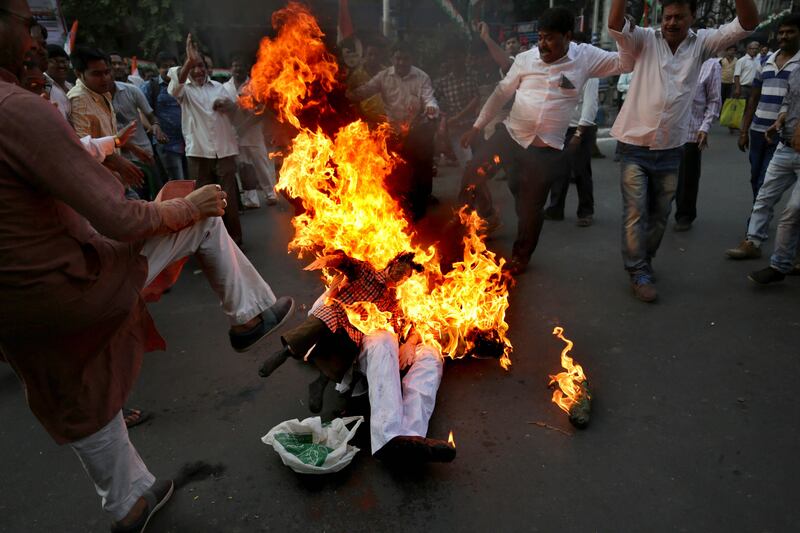The first anniversary on Wednesday of India’s demonetisation drive sparked a political battle, with the government and the opposition engaging in fierce slanging matches over the scheme’s ramifications.
Rhetoric about the drive, which was announced by prime minister Narendra Modi on November 8 last year, seeped into campaign speeches in Himachal Pradesh and Gujarat ahead of elections in those states on Thursday and in early December respectively. Eighteen opposition parties also came together to hold protests in the capital, New Delhi, and other Indian cities, calling November 8 a “black day” that hurt India’s economy and its citizens.
In a shock move a year ago, Mr Modi announced that 500-rupee and 1,000-rupee notes would cease to be legal tender. Indians were given less than two months to deposit their high value currency in banks.
The tactic was intended, Mr Modi said at the time, to punish tax evaders who held large, undeclared stocks of currency known as “black money”. The guilty would be unable to deposit such money into their accounts without acknowledging that they hadn’t paid taxes on it; after the two-month deadline, the currency would suddenly be worthless.
There is little evidence to suggest the drive succeeded at achieving this objective, but Mr Modi and his ministers continue to defend it. Speaking at an election rally in the Himachal Pradesh town of Kullu on Sunday, the prime minister said: “A few people who faced the heat of demonetisation are still complaining and are planning to observe 8 November as a ‘Black Day’. [They] cannot scare me by burning my effigies.”
__________________
Read more:
[ India still scarred a year after Modi's demonetisation move ]
[ Demonetisation was a trigger for India’s digital payments industry ]
[ India's former central bank head warned government on demonetization impact ]
__________________
Mr Modi’s ministers took to both the media and Twitter on Wednesday, claiming that demonetisation had yielded numerous benefits. Defence minister Nirmala Sitharaman said that by restricting the flow of cash “terrorism has been badly hit”.
Goa chief minister Manohar Parrikar, a member of Mr Modi's Bharatiya Janata Party (BJP), meanwhile said that demonetisation had brought about an “increase in financial inclusion & formalisation of our economy”. Cashless transactions, he implied, brought the poor into the banking network and turned the “informal”, difficult-to-track businesses into formal ones.
But those protesting against demonetisation were having none of it.
In rallies across India, Congress and other opposition parties, including the Communist Party of India (Marxist) and the Aam Aadmi Party, insisted that demonetisation had achieved none of its stated goals and had additionally wrecked the economy.
"Desh bhugat raha hai," placards proclaimed, "India is suffering". Political workers protested outside the Reserve Bank of India's office in Delhi in the morning, many wearing black. At 8pm — the precise hour when Mr Modi made his announcement last year — opposition parties held candlelight processions.
Rahul Gandhi, the vice-president of Congress, led the evening procession in Surat, a hub of diamond processing and textile manufacturing in Gujarat, Mr Modi's home state. Surat was hit particularly hard by demonetisation and then by the subsequent imposition of a new sales tax regime.
Last year, Surat produced 40 million metres of synthetic fabric daily. Now, production is down to 25 million metres. Thousands of workers who had been employed in the town’s small looms lost their jobs.
The situation in Surat mirrors that across India. In a Financial Times opinion piece published on Tuesday, Mr Gandhi quoted figures from the Centre for Monitoring Indian Economy think tank to point out that 1.5 million people had lost their jobs in the first four months of 2017 due to demonetisation.
Calling demonetisation a “tragedy”, Mr Gandhi wrote: “Demonetisation has wiped out 2 per cent of India’s gross domestic product, destroyed the informal labour sector and has wiped out many small and medium businesses.”
The macroeconomic effects of demonetisation are also reminders of the stories of individual human suffering reported in the last two months of last year. At least 80 people died standing in the long queues that formed outside ATMs, while at least one baby died because the hospital wouldn’t accept its mother's demonetised notes.
These tales of suffering are all the more worse given that the goal of eradicating black money does not seem to have been achieved. In its annual report, India's central bank stated that 15.28 trillion rupees worth of demonetised banknotes — out of a total circulating value of 15.44 trillion rupees — had come back into bank accounts.
These figures are at odds with those put forward by the Indian government when it announced the demonetisation drive. It predicted that a third of the 15.44 trillion rupees — which was thought to be held as black money — should have remained outside the banking system.
The results of the demonetisation scheme showed that the government had been mistaken in its assumptions, said C Rammanohar Reddy, an economist and the author of a book on demonetisation.
In reality, Mr Reddy told The National, most unaccounted wealth was held in the form of land or other physical goods, rather than as cash. "And what was held as cash was not going to be destroyed or revealed by demonetisation," he said, because the people who were evading taxes on a large scale were powerful enough to launder the money "and recycle it in different ways into the banking system".
Even Manmohan Singh, the former Congress prime minister and a distinguished economist, abandoned his usual reserve to speak out against demonetisation on Tuesday.
Mr Singh had warned last year — correctly, as it turned out — that India stood to lose 2 per cent of its GDP because of demonetisation.
Small businesses and citizens had been stripped of their wealth, Mr Singh told an audience of traders in Gujarat.
“Demonetisation was organised loot and plunder.”





